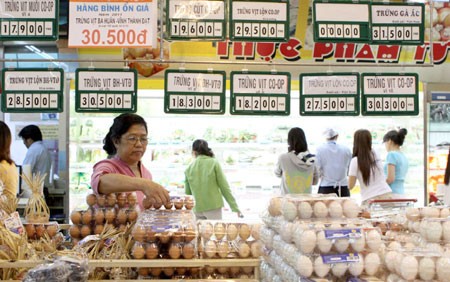(VOVworld) – In line with Vietnam’s commitment to WTO, beginning January 11, 2015, foreign retailers will be allowed to establish a 100% foreign owned business in Vietnam instead of the current maximum of 50%. From that point, Vietnamese retailers will have to compete directly with foreign businesses in the domestic market. What should Vietnamese companies do to attract customers and increase their market share?
By the end of last year, foreign businesses and retail corporations owned more than 40% of the 700 supermarkets in Vietnam, and 31 of 125 shopping centers in the form of joint-ventures with other foreign retailers.

Consumers shop for eggs at a supermarket in Ha Noi. The nation is predicted to have between 1,200-1,300 supermarkets and 180 shopping centres by 2020. (Photo: Pham Hau/ VNA/VNS)
|
Those figures show that Vietnam, with a population of 90 million, is attractive to foreign investors. Retail revenue in Vietnam is predicted to grow 23% per year. This means that Vietnam’s retail market faces great opportunities, given the trend toward shopping at supermarkets and modern retail stores. Many foreign retailers including BigC, Metro, LotteMart, Takashimaya, and Index Living Mall have expanded their investments in Vietnam.
This has challenged domestic retailers. Pham Ha Dong, general director of the Intimex Group, said in Vietnam’s restructuring plan, Vietnamese enterprises will focus on supermarkets in appropriate areas and will open more convenience stores. But what Vietnamese retailers need more than ever is government policies and mechanisms to support competition with foreign businesses and maintenance of domestic market share. Dong shares current difficulties of businesses:
“If land lease prices increase three to five fold, it will double input costs, causing greater difficulties for enterprises. So the state should consider how to use the money from land leasing to help businesses remain competitive. This is particularly important for companies who will be pressured by the expansion of foreign retailers into Vietnam this year and next year.”
 |
| Domestic retailers are striving to enhance their competitiveness as the time for Vietnam to open the domestic retail market is nearing |
Doctor Nguyen Dinh Cung, Director of the Central Institute for Economic Management, said the government must develop a law on retail, adjust the competition law, and combat transfer pricing. It also needs to re-organize the national retail system, train human resources, build infrastructure for the retail network, and reduce intermediate costs. Links between regions, enterprises, and distributors should be created to synchronize their strength. Cung said:
“Not just Vietnamese retailers, but all domestic businesses, are facing competitive pressure. The point is to make Vietnamese enterprises stronger. If trading is thought of as a battlefield, businesses are the soldiers, and the state is the rear which plays a key role in helping the front line.”
Vietnam is predicted to have between 1,200 and 1,300 supermarkets and 180 shopping centers by 2020. Supermarkets and shopping centers are expected to earn 45% of Vietnam’s total retail revenue for goods and services.
Vu Vinh Phu, chairman of Hanoi's supermarket association, said this is the time for domestic retailers to improve their business strategies to attract customers and increase market share. The important thing is to determine in which areas they are weak and make corrections. Phu recommends:
“Vietnam hasn’t got a strategy for retail industry development, but competitive pressure is rising from leading foreign retailers strong in capital, management capacity, business strategies, brand-recognition, and global distribution chains. We lack capital, trained personnel, and a professional system of supermarkets. And Vietnamese companies aren’t used to working closely with each other to compete with foreign rivals.”